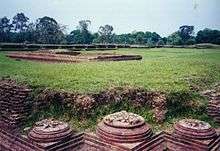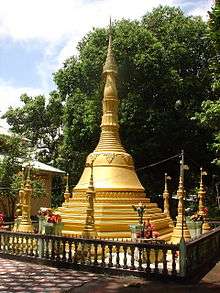Bengali Buddhists
| Total population | |
|---|---|
|
| |
| Languages | |
| Bengali | |
| Religion | |
| Buddhism | |
| Related ethnic groups | |
| Bengali Muslims, Bengali Hindus, Bengali Christians |
Bengali Buddhists, also known as Baruas,[1] are Buddhists of Bengali ethnic and linguistic identity. They commonly refer to the Barua community in southeastern Bangladesh. Bengali Buddhists constitute 35% of the Buddhist population in Bangladesh.
Buddhism has a rich ancient heritage in the Bengal. The region was a bastion of the ancient Buddhist Mauryan and Palan empires, when the Mahayana and Vajrayana schools flourished. South-eastern Bengal was ruled by the medieval Buddhist Kingdom of Mrauk U during the 16th and 17th centuries. The British Raj influenced the emergence of modern community.
Today, Bengali Buddhists are followers of orthodox Therevada Buddhism.
History
Ancient Bengal was a center of Buddhist learning, art and imperialism. Buddhist artifacts have been excavated throughout the region, particularly in Wari-Bateshwar, Chandraketugarh, Paharpur, Mahasthangarh and Mainamati. The Mauryan Empire led by Ashoka extended its suzerainty to the region in the 2nd century BCE. Ashoka played an important role in propagating Buddhism in his own empire and the wider ancient world.[2] Mauryan rule was succeeded by the Buddhist Samatata maritime kingdom in Bengal.
Successive Buddhist powers tussled for dominance with Hindu and Jain kings in the Indian subcontinent. The Bengali Buddhist Pala Empire arose during the 8th century. Founded by the election of Buddhist chieftain Gopala circa 750 CE, the empire grew into one of the largest imperial powers in classical Asia. The Palas promoted Mahayana and Tantric Buddhism. They patronized the creation of many outstanding temples, monasteries and works of art. The Palas enjoyed strong relations with the Abbasid Caliphate, the Tibetan Empire and the Srivijaya Empire. The empire reached its peak under Dharmapala and Devapala. They reigned for four centuries until being replaced by the resurgent Hindu Sena dynasty. Brahmin persecution played a key role in the decline of Buddhism in India; followed by later Muslim conquest.[3]

Remnants of Buddhist communities continued to flourish in southeastern Bengal. The Buddhist Kingdom of Mrauk U ruled the region during the 16th and 17th centuries.
By the late 18th-century, the region was ceded to the British Empire. During this period, a revival movement developed [4] that led to the development of two orders of Theravada monks, the Sangharaj Nikaya and the Mahasthabir Nikaya.
Bengali Buddhists benefited from Western education during the British Raj in the early-20th century.[5] Professor Benimadhab Barua (1888-1948) was the first Asian to receive a Doctor of Letters degree from the University of London.[5] Bengali Buddhist activists and guerrillas were also active in the Bangladesh Liberation War.
Demographics

Bangladesh is home to the predominant section of the Bengali Buddhist community. They usually enjoy a high literacy rate and are found in the Bangladeshi middle class, particularly in the port city of Chittagong. Many members of community reside in Dhaka, Cox's Bazaar and Comilla. The eastern Indian state capitals of Agartala and Kolkata also host major sections of the community.
Culture
Festivals
Buddha's Birthday is a public holiday in Bangladesh.
Bengali Buddhists also celebrate the festival of Madhu Purnima.
Literature
Bipradash Barua is a Bangladeshi author and novelist.
Music
Partha Barua is one of the pioneers of Bangladeshi rock.
See also
References
- ↑ http://www.buddhanet.net/e-learning/buddhistworld/bangladesh-txt.htm
- ↑ Jerry Bentley, Old World Encounters: Cross-Cultural Contacts and Exchanges in Pre-Modern Times (New York: Oxford University Press, 1993), 46.
- ↑ http://www.bmri.org.uk/articles/pre-islam_bengal_society.pdf
- ↑ "Jewel in the Crown: Bengal's Buddhist Revival in the 19th and 20th Centuries".
- 1 2 "Opinion - A glimpse of Buddhism in ancient Bangladesh". buddhistchannel.tv.
